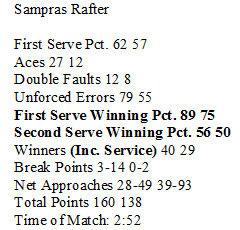Sampras d. Rafter 6-7 (10-12), 7-6 (5), 6-4, 6-2
SERVICE
Sampras had 27 aces, 12 doubles. He hit 42 other serves that Rafter could not get back; I gave him 9 service winners on those.
Rafter had 12 aces, 8 doubles. He hit 54 other serves that Sampras could not get back; I gave him 3 service winners on those.
Sampras won 101 of 132 points on serve (77%). Rafter won 107 of 167 (or 64%).
WINNERS
Sampras had 39 winners apart from service: 14 FH, 15 BH, 3 FHV, 7 BHV.
Rafter had 29 winners apart from service: 3 FH, 5 BH, 6 FHV, 14 BHV, 1 overhead.
Sampras hit 11 return winners, all passes; 8 came from the backhand. All 3 of the forehands, and 2 of the backhands, were returns of first serves. He had 14 other passing shots (8 from the forehand).
Rafter hit 4 return winners, all of them passes, two from each side. All were returns of second serves, except one backhand. He had 3 other passing shots, all backhands.
Neither player had a lob winner.
Sampras hit three-quarters of his winners with ground strokes.
ERRORS (FORCED AND UNFORCED)
As mentioned above, Sampras made an error on 54 returns (21 FH and 33 BH). Rafter made an error on 42 returns (16 FH and 26 BH).
Apart from returns, Sampras put out 16 attempted passing shots (including 13 BH), while Rafter put out 15 (including 12 BH, of which three were lobs).
Sampras made 15 other errors (3 FH, 2 BH, 9 FHV, 1 BHV), while Rafter made 30 (4 FH, 4 BH, 8 FHV, 14 BHV).
In all I counted 172 errors of one kind or another (85 by Sampras, 87 by Rafter), apart from their 20 double-faults (12 by Sampras, 8 by Rafter). With doubles, it’s 192. Add that to the 39 aces (27 by Sampras, 12 by Rafter) and 68 remaining winners (39 by Sampras, 29 by Rafter), and I’ve got 299 points, the same as the ATP and one more than Sports Illustrated.
SERVICE
Sampras had 27 aces, 12 doubles. He hit 42 other serves that Rafter could not get back; I gave him 9 service winners on those.
Rafter had 12 aces, 8 doubles. He hit 54 other serves that Sampras could not get back; I gave him 3 service winners on those.
Sampras won 101 of 132 points on serve (77%). Rafter won 107 of 167 (or 64%).
WINNERS
Sampras had 39 winners apart from service: 14 FH, 15 BH, 3 FHV, 7 BHV.
Rafter had 29 winners apart from service: 3 FH, 5 BH, 6 FHV, 14 BHV, 1 overhead.
Sampras hit 11 return winners, all passes; 8 came from the backhand. All 3 of the forehands, and 2 of the backhands, were returns of first serves. He had 14 other passing shots (8 from the forehand).
Rafter hit 4 return winners, all of them passes, two from each side. All were returns of second serves, except one backhand. He had 3 other passing shots, all backhands.
Neither player had a lob winner.
Sampras hit three-quarters of his winners with ground strokes.
ERRORS (FORCED AND UNFORCED)
As mentioned above, Sampras made an error on 54 returns (21 FH and 33 BH). Rafter made an error on 42 returns (16 FH and 26 BH).
Apart from returns, Sampras put out 16 attempted passing shots (including 13 BH), while Rafter put out 15 (including 12 BH, of which three were lobs).
Sampras made 15 other errors (3 FH, 2 BH, 9 FHV, 1 BHV), while Rafter made 30 (4 FH, 4 BH, 8 FHV, 14 BHV).
In all I counted 172 errors of one kind or another (85 by Sampras, 87 by Rafter), apart from their 20 double-faults (12 by Sampras, 8 by Rafter). With doubles, it’s 192. Add that to the 39 aces (27 by Sampras, 12 by Rafter) and 68 remaining winners (39 by Sampras, 29 by Rafter), and I’ve got 299 points, the same as the ATP and one more than Sports Illustrated.


